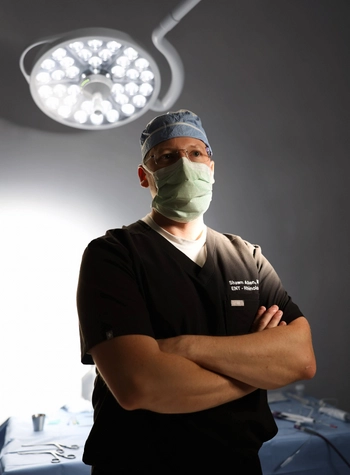Dr. Shawn Allen has either authored or reviewed and approved this content.
Page Updated:When enlarged turbinates block your breathing, specialized care makes all the difference. Dr. Shawn Allen’s fellowship-trained expertise in minimally invasive turbinate reduction can have you breathing effortlessly again. Through precise techniques and cutting-edge technology, we can restore natural airflow while preserving essential nasal function.

Your inferior turbinates are curved structures inside your nose that warm, humidify, and filter incoming air. Think of them as your nose’s sophisticated climate control system. When healthy, they regulate airflow seamlessly throughout the day.
However, chronic inflammation can cause these structures to swell permanently, creating persistent congestion that disrupts sleep, exercise, and daily comfort.
Understanding the root causes of turbinate enlargement helps determine the most effective treatment approach. Common factors include:
Turbinoplasty is an advanced outpatient procedure that reduces enlarged turbinate tissue while preserving essential nasal function. Dr. Allen employs sophisticated techniques that target problematic volume without compromising your nose’s natural ability to condition air.
This precision approach delivers meaningful symptom relief while maintaining long-term nasal health—a careful balance that requires specialized expertise.
Dr. Allen selects the optimal technique based on your specific anatomy and severity of your condition. He’ll discuss your options in depth and offer his expert advice. His advanced arsenal includes:
Every turbinoplasty is designed with specific, measurable objectives that align with your breathing transformation. Dr. Allen’s precision approach targets these key outcomes:

Turbinoplasty delivers exceptional results for nasal breathing challenges that resist medical management. Dr. Allen’s specialized expertise addresses:
After the procedure, many patients experience their first full nasal breath in years. They also enjoy better sleep quality as mouth breathing, snoring, and frequent waking at night diminish.
You’ll also experience an enhanced capacity for exercise, allowing for a return to your peak performance. You may also be able to reduce your medication dependence as your improved anatomy allows for treatments to reach their targets effectively.
Most importantly, lasting symptom control provides relief that will continue to improve over time.
Dr. Allen’s thorough evaluation will combine advanced diagnostics with a detailed discussion of your history and symptoms. Comprehensive nasal endoscopy will reveal your precise turbinate anatomy while CT imaging shows the full extent of enlargement and contributing factors.
Collaborative treatment planning ensures you understand your specific anatomy and how the procedure addresses your breathing concerns. Our experienced team handles insurance authorization seamlessly, removing barriers to your care.
Turbinoplasty is performed in Dr. Allen’s accredited facility using advanced monitoring for optimal safety and comfort. Local anesthesia with sedation ensures complete comfort while allowing surgical precision.
Minimally invasive endoscopic techniques achieve maximum reduction with minimal tissue trauma. Real-time visualization through high-definition endoscopy enables unprecedented precision while preserving crucial anatomical relationships.
Dr. Allen’s refined techniques ensure smoother recovery with faster return to activities. Initial swelling during the first week is normal as tissues begin healing. Nasal irrigation begins within days, promoting optimal healing.
Most patients return to desk work within 2-3 days and full activities within two weeks. Progressive improvement continues for months as final results emerge, delivering dramatic, lasting enhancement in breathing capacity.
Modern turbinate reduction preserves specialized olfactory regions while addressing obstructive tissue. Dr. Allen’s precise approach maintains smell detection anatomy, and many patients experience improved scent perception as better airflow carries molecules more effectively to receptors.
Properly performed turbinate reduction provides permanent structural changes maintaining long-term improvement. Dr. Allen’s techniques preserve sufficient tissue for function while eliminating excess volume. Success depends on addressing underlying causes like allergies to prevent recurrence.
Most patients notice meaningful improvement within one week as initial swelling subsides. Significant enhancement typically appears by two weeks, with optimal results achieved over 2-3 months as healing completes.
Absolutely. Dr. Allen frequently combines turbinate reduction with septoplasty for comprehensive nasal breathing improvement. Endoscopic sinus surgery pairs naturally with turbinoplasty to optimize both drainage and airflow.
Sleep apnea procedures can be coordinated to address multiple breathing obstacles simultaneously, maximizing improvement while minimizing recovery burden.

Your effortless breathing deserves fellowship-trained expertise. Dr. Shawn Allen’s specialized experience in advanced turbinate reduction, combined with innovative techniques and patient-centered care, ensures transformative results that last.
Experience the difference that true expertise makes in achieving lasting relief from nasal breathing challenges. Reach out to discover how sophisticated turbinate reduction can restore the natural breathing that transforms daily life.
Dr. Shawn Allen has either authored or reviewed and approved this content.
Page Updated: